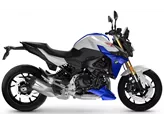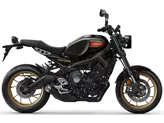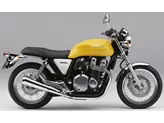Yamaha XSR900 2016 vs. Kawasaki Z900 2017

Yamaha XSR900 2016

Kawasaki Z900 2017
Pregled - Yamaha XSR900 2016 vs Kawasaki Z900 2017
The Yamaha XSR900 2016 and the Kawasaki Z900 2017 are both naked bikes with similar technical specifications. However, there are some notable differences between the two models.
In terms of engine power, the Kawasaki Z900 2017 has a slight advantage with 125.4 HP compared to the Yamaha XSR900 2016's 115 HP. The Kawasaki also has a higher torque of 98.6 Nm compared to the Yamaha's 87.5 Nm. This means that the Kawasaki may offer slightly better acceleration and overall performance.
Both bikes have in-line engines with liquid cooling, but the Yamaha XSR900 2016 has a 3-cylinder engine while the Kawasaki Z900 2017 has a 4-cylinder engine. The larger displacement of the Kawasaki at 948 ccm compared to the Yamaha's 847 ccm may also contribute to its higher power output.

Yamaha XSR900 2016
In terms of suspension, both bikes have upside-down telescopic forks at the front and swing arm suspension with a monoshock at the rear. This setup provides good stability and handling for both models.
The chassis of the Yamaha XSR900 2016 is made of aluminum and has a twin tube frame, while the Kawasaki Z900 2017 has a steel frame with a double cradle design. The choice of materials and frame design may affect the overall weight and handling characteristics of the bikes.
Both bikes have double disk brakes at the front with similar diameters of 298 mm for the Yamaha and 300 mm for the Kawasaki. This ensures good stopping power and control in various riding conditions. Additionally, both models come with ABS as standard, providing added safety and confidence during braking.
In terms of dimensions, the Yamaha XSR900 2016 and the Kawasaki Z900 2017 have similar front and rear tire widths and diameters. However, the Kawasaki has a slightly longer wheelbase at 1450 mm compared to the Yamaha's 1440 mm. The seat height of the Yamaha is also slightly higher at 815 mm compared to the Kawasaki's 795 mm.

Kawasaki Z900 2017
In terms of strengths, the Yamaha XSR900 2016 is praised for its powerful engine, well-tuned riding modes, and the inclusion of ABS and TC as standard. It also has an authentic modern design and clean workmanship. On the other hand, the Kawasaki Z900 2017 is commended for its ingenious naked bike chassis, superb looks, and a responsive engine with perfectly dimensioned torque. It is also considered to be an optimal intersection of performance, price, and practical use.
In terms of weaknesses, the Yamaha XSR900 2016 is criticized for its hard chassis and a seat that could be more comfortable. Additionally, some may find the speedblock design to be repetitive, as it is already present on many other Yamaha models. The Kawasaki Z900 2017 is noted to have a narrow knee angle, which may be uncomfortable for taller riders. However, this can be addressed by ordering a different seat.
Overall, both the Yamaha XSR900 2016 and the Kawasaki Z900 2017 are impressive naked bikes with their own unique strengths and weaknesses. Riders should consider their personal preferences and priorities to determine which model suits them best.
Tehnične specifikacije Yamaha XSR900 2016 v primerjavi z Kawasaki Z900 2017
Primerjava prednosti in slabosti
Primerjava prednosti in slabosti
Yamaha XSR900 2016

The XSR900 combines the performance of a sporty streetfighter with the look of a pleasing, cleanly finished retro naked bike. In doing so, the Japanese make use of their own history, which can be found bundled and without gaps in the archive of the design agency that has been working for Yamaha for 60 years. It adopts the virtues of the MT-09 and has mended some of its weaknesses. It rides more harmoniously, more controlled and, if desired, more relaxed. Only the comfort, and thus the rider, suffers from the tight chassis on bad roads. You have to be a little bit sensitive when it comes to a neo-classic.
Kawasaki Z900 2017

An incredibly well-designed motorbike. A lot of test work and attention to detail went into it. It has exactly the right power, exactly the right chassis and exactly the right look. An all-round successful naked bike that will make you happy for a long time. If you like, you can ride it simply and faithfully, but if you want, you can also ride it really fast and it wheels like hell. Great!
Primerjava povprečnih tržnih cen Yamaha XSR900 vs Kawasaki Z900
There are a few key differences between a Yamaha XSR900 2016 and a Kawasaki Z900 2017. In terms of price, the actual average price of a Kawasaki Z900 2017 is about 32% higher. A Yamaha XSR900 2016 experiences a loss of 1,650 USD in one year and 1,670 USD in two years of ownership. This is offset by a loss of 520 USD and 920 USD for a Kawasaki Z900 2017. Compared to Kawasaki Z900 2017 there are less Yamaha XSR900 2016 bikes available on the 1000PS.de Marketplace, specifically 5 compared to 43. It takes less time to sell a Yamaha XSR900 with 77 days compared to 85 days for a Kawasaki Z900. Since model year 2016 1000PS.de editors have written 30 reviews for the Yamaha XSR900 and 46 reviews for the Kawasaki Z900 since model year 2017. The first review for the Yamaha XSR900 was published on 11/25/2015 and now has more than 17,600 views. This compares to more than 93,200 views for the first review on Kawasaki Z900 published on 11/11/2016.
















